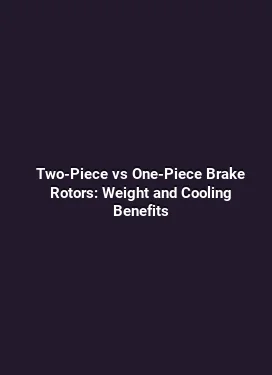Carbon Ceramic Brakes vs Steel Rotors: Cost and Performance Analysis
Technology Foundations and Material Differences

Brake systems are composed of several interacting components: rotors, pads, calipers, and the hydraulic system that powers engagement. Carbon ceramic brakes replace a traditional cast iron rotor with a carbon fiber-reinforced ceramic composite. This change brings a distinct set of properties: high thermal stability, low thermal expansion, and excellent resistance to heat-induced wear. In contrast, steel rotors, typically cast iron or steel alloys, excel in initial cost, broad compatibility, and predictable friction behavior. The fundamental material distinction drives much of the performance narrative, especially under demanding driving conditions such as track sessions or high-speed highway driving where heat generation can exceed the conductor capacity of standard rotors.
From a metallurgical standpoint, ceramic composites maintain structural integrity when subjected to repeated thermal cycling. They exhibit lower weight per rotor area, which can influence unsprung mass and steering response. However, the brittleness of ceramic materials means that rotor design and mounting tolerances become critical to prevent fracture under impact loads or severe racing-style braking calipers. The integration with high-temperature compatible pads, clutch-like cooling channels, and specialized calipers completes the ecosystem that enables the performance advantages to emerge.
Material Science and Thermal Management

Understanding heat flow is central to performance analysis. Carbon ceramic rotors dissipate heat more efficiently at elevated temperatures, reducing the risk of brake fade during repeated high-speed braking. Thermal conductivity, heat capacity, and surface stability contribute to a more consistent friction profile across a wide temperature range. In practice, this means drivers can maintain more aggressive braking late into a lap without the typical drop in braking force seen on steel rotors. Yet, at low temperatures, carbon ceramic brakes can feel less responsive until they reach operating temperature, a characteristic that requires a brief adaptation period for new users or vehicles equipped with complex brake-by-wire systems.
Pad chemistry plays a complementary role. Low-copper or copper-free pad formulations are often paired with ceramic rotors to optimize pad wear, bite, and cleanliness. This pairing can influence rotor conditioning behavior, including initial bedding procedures and the presence of a light color change on rotor surfaces after energetic braking sessions. The interplay between rotor material and pad selection is a central thread in any long-term performance assessment.
Performance Metrics: Stopping Power, Fade, and Consistency
Performance assessment hinges on several key metrics: stopping power, fade resistance, modulation, and consistency across temperature bands. Carbon ceramic brakes typically demonstrate superior fade resistance thanks to their stable thermal properties. As heat input accumulates during sustained braking, ceramic composites maintain a more uniform coefficient of friction, which translates to predictable deceleration and better control in demanding conditions. This stability is especially valuable on race-trained vehicles and performance cars used for track days, where braking demands are intense and variable.
Steel rotors, while offering excellent initial bite and a forgiving feel, often experience friction coefficient decline as temperatures rise. This fade effect can lead to a softer pedal feel and a need for longer stopping distances in high-demand scenarios. However, for everyday driving, steel rotors provide reliable, linear response with broad compatibility across pad compounds and caliper designs, which translates into straightforward maintenance and lower upfront costs.
Endurance and Wear Profiles
Carbon ceramic components exhibit exceptional wear resistance under radial and axial stresses, leading to a longer rotor life in high-performance contexts. While the rotor itself is more expensive, the reduced wear can lower long-term maintenance frequency for fleets and enthusiasts who log many track miles. In contrast, steel rotors wear more quickly under aggressive use, but their cost and availability make replacement budgeting straightforward and predictable for most drivers.
Cost Considerations: Upfront vs Long-Term Value
Initial investment for carbon ceramic brakes is significantly higher than for steel rotors. The price delta reflects material costs, manufacturing complexity, and the need for compatible calipers and pads engineered for ceramic surfaces. For a high-performance or track-focused vehicle, the upfront cost may be justified by benefits including reduced rotor wear, improved fade resistance, and potential gains in usable tire life due to more stable braking forces. In fleet operations or daily drivers, the payback period can be extended, as replacement intervals for steel rotors are shorter and parts are widely available at lower price points.
Another cost dimension is maintenance and servicing. While standard rotors and pads are easier to source globally, carbon ceramic systems typically require specialized inspection routines, torque specifications, and bedding procedures. This can translate into higher service labor costs and the need for dealer or specialized shop support. Nevertheless, the longer rotor life and reduced brake dust can yield savings in maintenance logistics and cleaner wheels over time, particularly for luxury or performance models that accumulate significant miles.
Lifecycle Economics and Depreciation Considerations
When evaluating lifecycle economics, it is helpful to consider vehicle usage patterns, resale value, and potential performance premiums. Cars equipped with carbon ceramic brakes may command higher residual values in markets where enthusiasts and track-day participants browse for specialty options. The improved thermal stability and reduced maintenance nuisance can also appeal to owners who aim to maximize out-of-pocket costs per mile, even if initial prices are higher. Conversely, in markets with limited service infrastructure or lower usage intensity, the total cost of ownership can lean toward steel rotors as the practical choice.
Durability, Maintenance, and Real-World Servicing
Durability in automotive braking systems is a blend of rotor endurance, pad life, caliper integrity, and the effectiveness of cooling. Carbon ceramic rotors are designed to withstand repetitive thermal cycles without the microcracking or excessive wear that can afflict iron rotors under extreme use. However, they are not invulnerable: impacts from road hazards, improper bedding, or misaligned calipers can cause rotor damage, and replacement may require factory or authorized service channels to ensure compatibility with the rest of the system.
Maintenance routines differ between rotor types. Iron rotors benefit from straightforward inspection for wear, thickness variations, and runout. Ceramic rotors demand careful checks for cracks, delamination risks, and a stricter bedding protocol when new pad compounds are installed. Pads used with ceramic rotors often need to avoid certain friction materials that could cause glazing or accelerated wear, while ensuring consistent bite and quiet operation. The scheduling of inspections, rotor thickness measurements, and caliper condition assessments can be more nuanced on vehicles equipped with ceramic systems, making professional guidance valuable for optimal performance.
Bed-In Procedures and Use-Case Scenarios
Proper bed-in procedures help establish a consistent friction surface and prevent glazing. For carbon ceramic setups, bedding often involves a specific sequence of moderate-speed braking with controlled heat buildup, followed by a cooling period. In contrast, steel rotors typically follow a simpler bed-in process that focuses on achieving even pad contact and stable friction across a range of operating temperatures. Real-world use cases include daily commuting, weekend canyon runs, and dedicated track days, each with distinct brake temperature profiles that influence the appropriate rotor choice and maintenance cadence.
Applications by Vehicle Type and Driving Profile
Vehicle type and driving profile strongly influence rotor selection. Performance sedans and sports cars that frequently engage in spirited driving or track sessions benefit from carbon ceramic systems due to heat resilience and reduced rotor wear. High-performance SUVs and GT cars may experience improved brake feel and control at sustained high speeds, contributing to enhanced driver confidence. For compact city cars and everyday commuters, steel rotors offer an economical balance of performance and practicality, with broad availability of components and service options.
In endurance and racing contexts, the demand for consistent braking at high temperature can make carbon ceramic brakes a compelling option, particularly when maintenance windows are limited and the risk of rotor warping or fade must be minimized. However, teams and owners should evaluate the total cost of ownership, including aftercare, replacement parts, and potential upgrades to compatible calipers and pads tailored to ceramic performance characteristics.
Practical Installations: Fitment, Compatibility, and Setup
Fitment considerations are essential when upgrading to carbon ceramic brakes. Vehicle manufacturers often design caliper and rotor assemblies as integrated systems, with specific mounting patterns, hub interfaces, and wheel clearance requirements. Before committing to a retrofit or factory upgrade, owners should verify kit compatibility with existing wheels, caliper clearance, brake fluid capacity, and the presence of ABS and electronic stability control integration. Pad alignment, rotor runout, and rotor surface condition require precise measurement tooling and adherence to manufacturer torque specs to prevent uneven wear or noise generation.
Wheel choice can influence cooling effectiveness and pad contact dynamics. Larger wheels with optimized airflow around the braking components may enhance thermal management, while certain wheel designs can inadvertently trap heat. Practical guidance includes confirming heat dissipation pathways, ensuring adequate caliper clearance, and coordinating with service professionals to schedule bedding and inspection routines after installation.
Trend Analysis and Real-World Implications
In today’s performance market, there is a growing emphasis on materials science and engineering that address repeated high-load scenarios, such as track days and time attack events. The trend toward lighter, thermally stable rotor materials aligns with broader goals of reducing unsprung mass and improving vehicle dynamics. Additionally, there is an ongoing push toward cleaner manufacturing practices and reduced particulate emissions from braking systems, which has driven development in ceramic composites and friction materials with lower copper content. Operators who track these developments can identify opportunities to optimize braking strategy for various surfaces, temperatures, and driving styles without sacrificing daily usability.
From the perspective of maintenance planning, car owners and teams increasingly rely on data-driven monitoring of brake temperature, pad wear indices, and rotor health indicators. The integration of telematics and diagnostic tools helps anticipate service intervals and optimize performance windows, enabling a smoother transition between different driving modes, whether on a public road or a controlled track environment.
Case Studies: Real-World Comparisons and Scenarios
Consider a mid-size sports sedan used for weekend track events. A ceramic rotor setup can maintain effective braking across multiple sessions with less rotor wear, potentially reducing the frequency of rotor replacement and the time spent in the pit. The initial investment is higher, but the long-term maintenance cost and performance consistency can be compelling for owners who regularly push their vehicles to the limit. Conversely, a daily driver that prioritizes cost efficiency and ease of service may benefit from steel rotors and standard pads, offering dependable performance with widespread service network support.
Another example involves a high-performance hatchback used for mountainous routes and occasional track days. In this scenario, the driver might experience a more predictable fade resistance with ceramic rotors, enabling more aggressive braking into corners. The trade-off includes careful bedding, consideration of pad selection, and a servicing plan that accounts for the specialized nature of ceramic systems, as well as potential downtime for maintenance in between events.
Conclusion-Free Insight: Practical Takeaways for Enthusiasts
For enthusiasts evaluating braking upgrades, the decision matrix centers on intended use, budget, and maintenance expectations. The enhanced thermal stability and wear resistance of carbon ceramic brakes translate into meaningful performance benefits for frequent high-load driving and track use, while the lower upfront cost and easier serviceability of steel rotors make them a pragmatic choice for everyday driving. By aligning brake material choice with driving profile, owners can optimize pedal feel, deceleration consistency, and overall driving confidence across diverse conditions.






